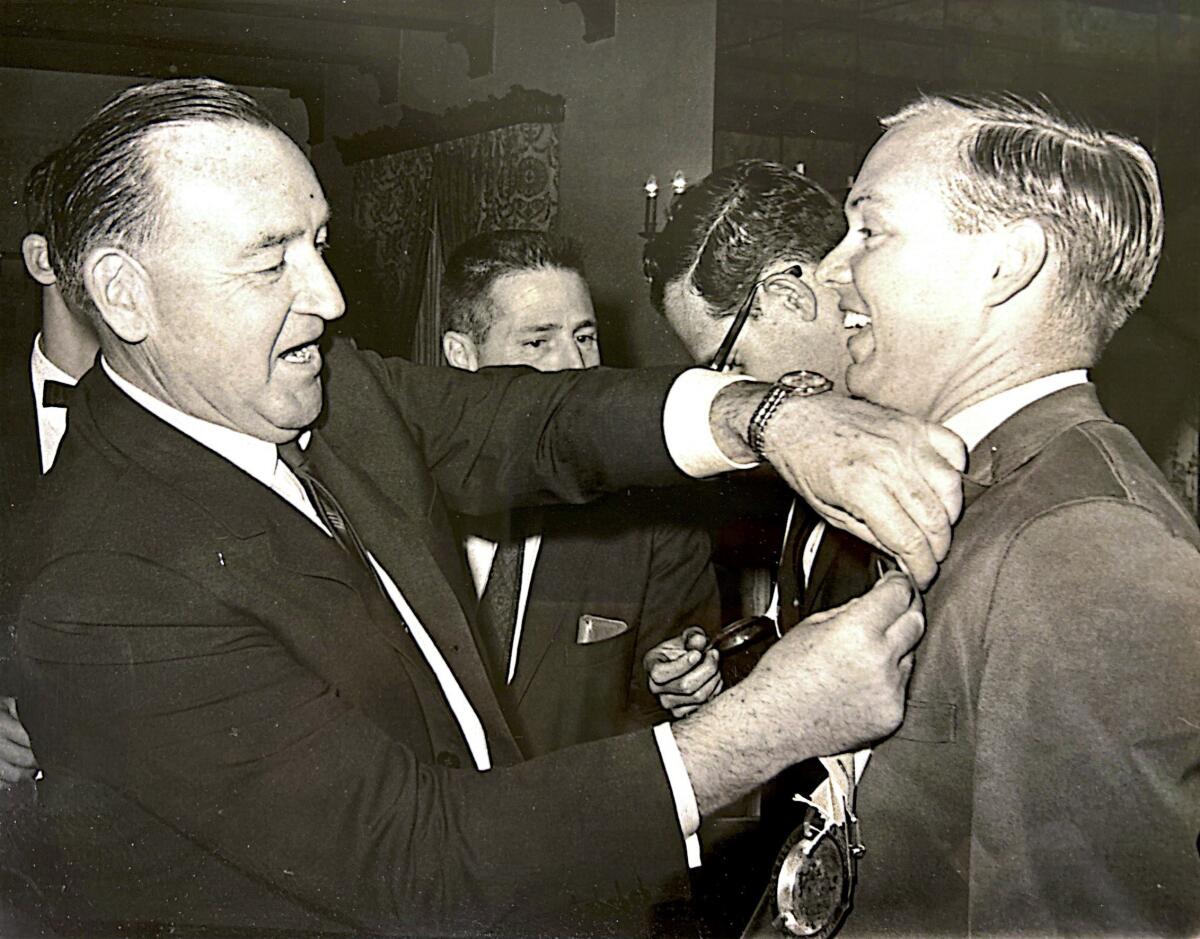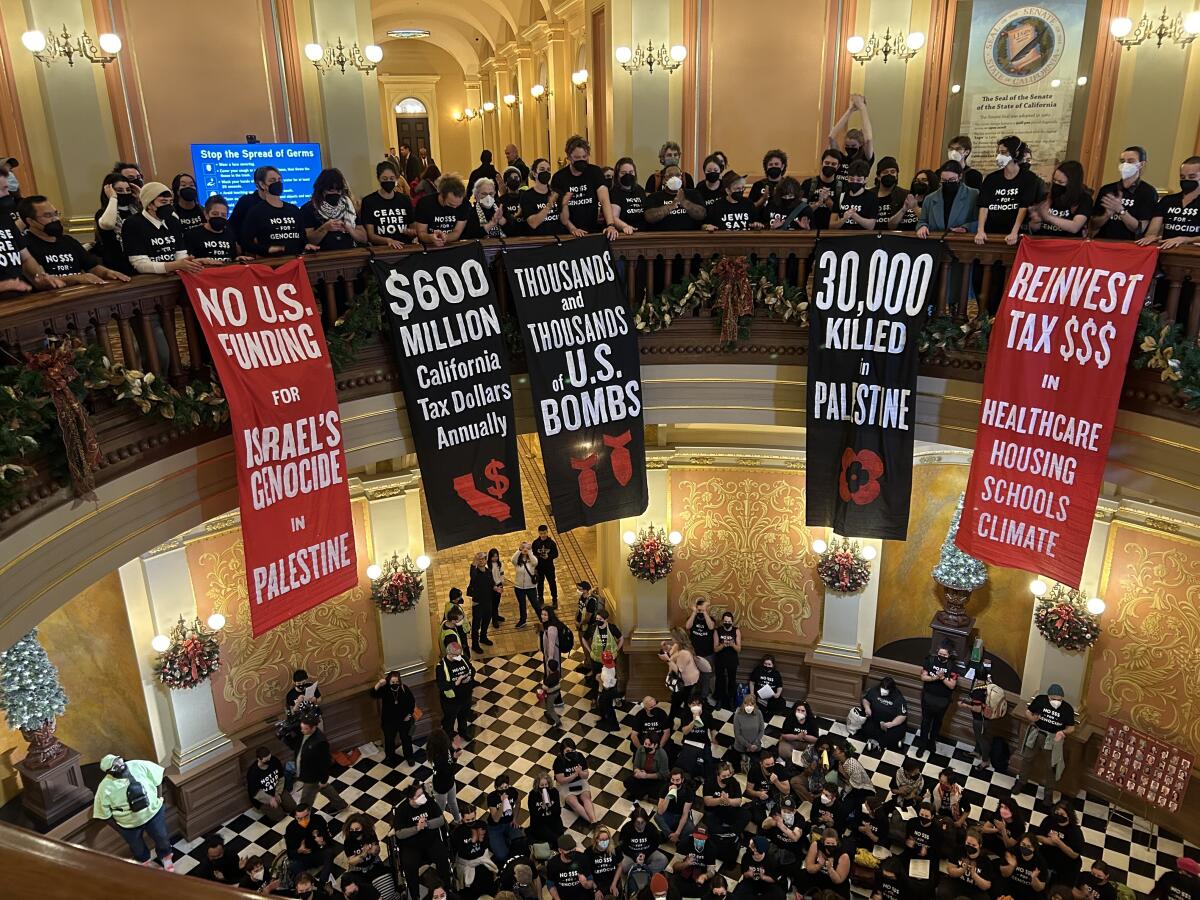George Skelton’s long view on California politics

- Share via
Fifty years ago this week, the Los Angeles Times hired a young political reporter named George Skelton. He had made his mark covering the state Capitol in Sacramento for other news outlets during the governorships of Pat Brown and Ronald Reagan, and joined The Times as Reagan began his last year in the governor’s office.
“In this kingdom of political animals, the most pathetic is often the lame duck, who flaps feebly in a sea of vultures,” Skelton wrote in his first article for The Times, published on Jan. 7, 1974. Despite his lame duck status, Skelton wrote, Reagan’s “political health in Sacramento has remained relatively stable.”
A 35-year-old Jerry Brown, Pat Brown’s son, was running for governor at the time. Skelton would go on to cover the younger Brown as governor — twice — as well as Reagan’s two terms in the White House. In Sacramento, he covered developments that are almost unthinkable now: a Republican governor (Reagan) signing the nation’s most liberal abortion law that some Democratic lawmakers opposed; another Republican governor (George Deukmejian) working with Democratic lawmakers to pass the nation’s first assault weapons ban.
Skelton launched his Capitol Journal column in 1993 amid the tough-on-crime era of California politics and the anti-illegal-immigration policies of Gov. Pete Wilson, with whom Skelton recalls drinking Scotch during interviews in the governor’s office. A generation later, some of the politicians Skelton covered at the Capitol were the same Latino leaders who’d once led street protests against Wilson. In between, Skelton chronicled the tumultuous recall of Gov. Gray Davis and the political rise and fall of Arnold Schwarzenegger.
His long view on California politics has made Skelton’s L.A. Times columns essential reading. But one of the things I have enjoyed most about working with Skelton in The Times’ Sacramento bureau is learning bits of history just by walking into his office. The walls are covered with photos from throughout his career — sporting sunglasses and a skeptical expression as he covered a Richard Nixon visit to Orange County in 1969, looking Reagan in the eye during a 1983 interview on Air Force One. A black and white photo of Pat Brown pinning something on the lapel of Skelton’s jacket prompted me one day to ask what was going on in the picture.
It was taken hours after Skelton survived a helicopter crash while covering Brown’s 1966 gubernatorial campaign, he told me. Skelton and another reporter had hopped into the copter at a stop near Los Angeles and were heading to Brown’s next campaign stop when the aircraft “lost power and almost smashed into the side of this four-story apartment building,” Skelton said.
The pilot was able to maneuver the helicopter enough to land on the building’s roof, Skelton said, but the crash landing ignited a fire when the helicopter broke several power lines.
“Fire engines came with a big long ladder, and we climbed down off the roof,” Skelton said.
By the time he got to Brown’s campaign reception that evening, the governor had heard all about it.
“He decided to grab an old tin ashtray, and put a ribbon on it,” Skelton said. “Wrote ‘hero’ on it and had a little ceremony, and pinned it on my chest.”
In honor of Skelton’s 50th anniversary with The Times this month, we’re rolling out our own version of a hero ribbon. LA Times Studios — the company’s video production arm — will soon debut a mini-documentary about the modern history of California politics as told through Skelton’s journalism. And I’ll be hosting a conversation with Skelton at a Sacramento Press Club luncheon toward the end of January. My goal is to draw out some of those stories about his crash landings and Air Force One interviews, ask for his advice to younger journalists and probe his observations on California’s political evolution. (Keep an eye on the Press Club’s website for ticket info.)
I’m Laurel Rosenhall, The Times’ Sacramento bureau chief, bringing you the week’s biggest news in California politics.
You are reading our Politics newsletter
Sign up to get an inside guide to the movers, shakers and lawmakers who shape the Golden State.
You may occasionally receive promotional content from the Los Angeles Times.
Legislature faces politics of Israel-Hamas war

On the day California lawmakers returned to Sacramento for the new year, hundreds of protesters convened at the state Capitol and shut down the Assembly with calls for Israel to stop its war against Hamas.
Legislators filed out of the Assembly chamber as demonstrators chanted, “Cease-fire now.” Filling the Capitol rotunda, protesters unfurled a banner stating “No U.S. Funding for Israel’s Genocide in Palestine” and made paper flowers representing more than 22,000 Palestinians killed in the war that began after Hamas attacked Israel on Oct. 7, killing about 1,200 people and taking 240 others hostage.
Wednesday’s protests thrust the complicated politics of the war into the California Capitol, which has been quiet while the Legislature was on recess for the fall. The U.S. response to the war has triggered a generational divide in the California electorate and a schism among Democrats, while polling shows California Republicans largely want the U.S. to support Israel.
Also on Wednesday, Assembly Republicans introduced a resolution condemning Hamas and the Legislature’s Jewish Caucus sent a seven-page letter to lawmakers describing fear among Jewish Californians amid an “explosion of hate directed at our community.”
Read more here: California Assembly shut down by protest calling for Israeli cease-fire
Classes for parents accused of child abuse go largely unregulated

Court-ordered parenting classes are routine in child abuse and neglect cases, but go largely unregulated in California, reporter Mackenzie Mays reveals in this new investigation.
The state does not ensure that parent education programs meet any sort of standards, allows parents facing abuse allegations to take classes that experts have deemed low quality, and cannot provide research evidence for half the programs listed in a state-funded database meant to act as a key tool for local officials to ensure child safety.
The lack of scrutiny can put some of California’s most vulnerable children — those whose parents are fighting for custody while under investigation by protective services — at risk.
“I don’t think judges look very closely at the quality of the parenting classes,” said former Judge Leonard Edwards, who oversaw child abuse cases for decades before retiring from the Santa Clara County Superior Court in 2006.
“It’s sort of a rubber stamp in most cases.”
Mays found that although national research shows some parenting classes can help prevent child abuse and keep deserving families together, in California they often amount to an overprescribed bureaucratic remedy with no clear track record of success. Participation in them can sway custody rulings despite a lack of oversight and data, according to more than 20 child welfare experts who spoke to The Times, including social workers, attorneys, retired judges, parents and providers.
Still, experts such as Edwards, who is a member of the California Child Welfare Council, believe in some of the programs and have seen them benefit children and parents.
“A good parenting class can change lives,” he said.
Here is the full article: Parenting classes are routinely ordered in child abuse cases. California isn’t ensuring they work.
Enjoying this newsletter? Consider subscribing to the Los Angeles Times
Your support helps us deliver the news that matters most. Become a subscriber.
Orange County’s swing voters

Four congressional districts in Orange County are expected to be among the nation’s most competitive in this year’s election as Republicans and Democrats fight to control the House.
A key group of voters who could sway the outcome of those races is what UC Irvine researchers describe as “modestly partisan Republicans,” Times reporter Hannah Fry writes. This group differs from traditional GOP voters, she reports in this article based on a new poll, because they’re wealthier, more diverse, more socially liberal and less resistant to taxes to solve key issues.
Once considered a heart of Southern California conservatives, Orange County’s transformation into a more culturally, economically and politically diverse region has forced congressional candidates to find ways to appeal to voters without a strong party preference. These voters not only will be pivotal not only in deciding whom Orange County sends to Washington, but also in determining the balance of power in Congress.
Read the full article here: Wealthier Asian American and Latino voters in Orange County may be pivotal in upcoming elections
Keeping up with California politics
Newsom urges support for March ballot measure to reform California’s mental health system
Gov. Gavin Newsom gathered with Los Angeles leaders and public safety officials Wednesday to urge support of Proposition 1, an overhaul of the state’s mental health system that will be on California’s March 5 primary election ballot.
How will California’s new laws affect you?
Hundreds of new laws took effect in California on Jan. 1. Here are some that could affect you at home, at work, at school and on the road.
Worried about AI? How California lawmakers plan to tackle the technology’s risks in 2024
California lawmakers have introduced a raft of legislation that sets the stage for more regulation of artificial intelligence in 2024. Some of the proposals focus on protecting workers, combating AI systems that can contribute to gender and racial biases and establishing new requirements to safeguard against the misuse of AI for cybercrimes, weapon development and propaganda.
California lawmakers want to curb retail theft, but say it’s not as easy as it sounds
While California lawmakers feel pressure to address concerns about crime, the murky and sometimes contradictory evidence of an increase in lawlessness has put legislators in a bind.
Judges let new California ban on guns in many public places take effect amid legal fight
A new California law barring licensed gun holders from carrying their firearms into an array of public places took effect Monday despite an ongoing legal challenge to its legitimacy. Whether the law will ultimately survive the court challenge and remain in place in the long run remains uncertain — but for now the state’s licensed gun holders must abide by it.
Who would lend millions to Hunter Biden? Meet the Hollywood lawyer who has
Kevin Morris has assumed several roles in Hunter Biden’s life, foremost as his lawyer, but also his friend, confidant and bankroller. He has lent millions of dollars to Biden to cover his tax debts, housing and legal fees. He has also helped build a community of people around Biden who support him in his sobriety. In standing by Biden, Morris himself has become a figure of speculation, scrutiny and, in some quarters, suspicion. Who is he? How has he become one of Biden’s closest confidants?
Stay in touch
Did someone forward you this? Sign up here to get California Politics in your inbox.
Until next time, send your comments, suggestions and news tips to capolitics@latimes.com.
Sign up for Essential California
The most important California stories and recommendations in your inbox every morning.
You may occasionally receive promotional content from the Los Angeles Times.







